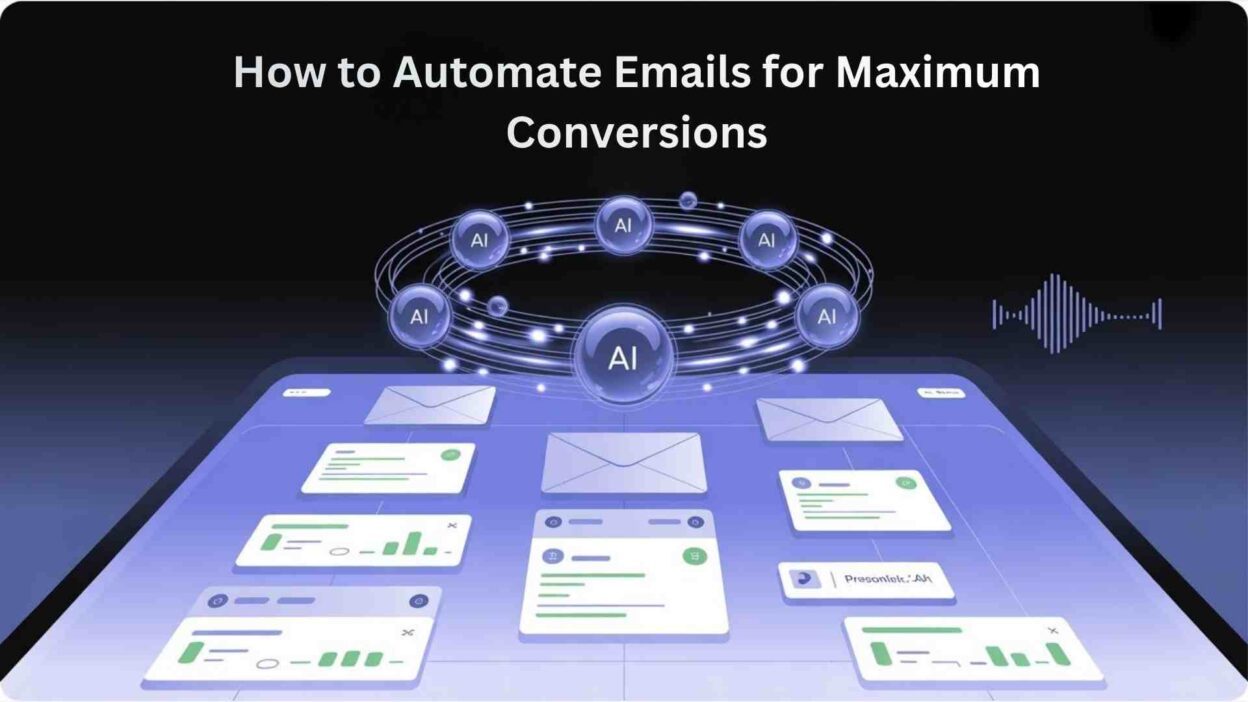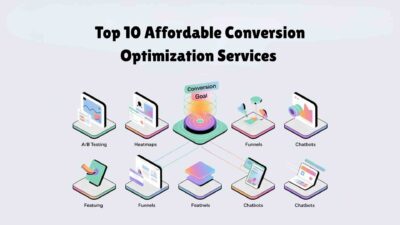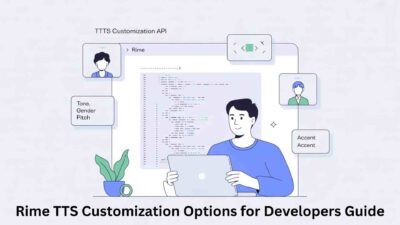TL;DR You send emails every day. Your customers expect them. Manual sending wastes hours of your time. Email marketing automation for conversions changes everything about how you communicate with buyers.
Table of Contents
Automation handles repetitive tasks for you. The system sends emails based on triggers you set. Someone signs up for your newsletter. They receive a welcome email instantly. No manual work required from your team.
Conversions mean getting subscribers to take action. They buy your product, book a consultation and download your guide. Every action that moves them closer to becoming a customer counts as a conversion.
Smart businesses combine automation with conversion goals. The result drives serious revenue growth. Your emails reach people at perfect moments. They see messages that match their interests. Sales happen while you sleep.
Why Your Business Needs Automated Email Campaigns Right Now
Manual email marketing drains your resources fast. Your team spends hours writing individual messages. They track responses in spreadsheets. Mistakes happen when humans handle repetitive work.
Automated systems never forget to follow up. They send birthday emails on exact dates. Cart abandonment messages go out three hours after someone leaves your site. Consistency builds trust with your audience.
Email marketing automation for conversions delivers personalized experiences at scale. You create templates once. The system customizes them for thousands of subscribers. Each person feels like you wrote their message specifically for them.
Revenue increases when you automate strategically. Studies show automated emails generate higher open rates than broadcast messages. Click-through rates jump because timing matches customer behavior. Your conversion rates improve month after month.
Understanding the Customer Journey Through Automated Emails
Every buyer goes through stages before purchasing. They discover your brand first. Curiosity brings them to your website. Questions form in their minds about your solutions.
Awareness stage subscribers need educational content. They want to understand their problems better. Your automated emails should teach them something valuable. No hard selling works at this phase.
Consideration stage, customers compare options actively. They look at your competitors. Your emails must highlight what makes you different. Case studies work brilliantly here. Customer testimonials build credibility fast.
Decision stage buyers need that final push. Limited-time offers create urgency. Clear guarantees remove their last objections. Simple checkout processes seal the deal.
Email marketing automation for conversions maps content to each stage perfectly. Someone downloads your beginner guide. They enter your awareness, nurture sequence. They click on a pricing page. Your system moves them to decision-stage emails automatically.
Timing matters more than most marketers realize. Send educational content too early and you waste opportunities. Push sales messages too late, and competitors win. Automation handles timing based on behavior data.
Building Your Email List the Smart Way
Quality beats quantity every single time. Ten engaged subscribers outperform a thousand uninterested people. Your list-building strategy determines long-term success.
Lead magnets attract your ideal customers. Create something they desperately want. Checklists solve immediate problems. Templates save them hours of work. Exclusive research gives them competitive advantages.
Opt-in forms need strategic placement across your website. Your homepage should have one above the fold. Blog posts deserve inline forms after valuable sections. Exit-intent popups catch people before they leave.
Segmentation starts the moment someone joins. Ask qualifying questions on your signup form. Industry type helps you customize messages. Company size determines relevant case studies. Pain points guide which sequence they enter.
Email marketing automation for conversions requires clean data from day one. Verify email addresses before adding people to lists. Remove fake signups immediately. Maintain strict permission-based practices always.
Growing your list takes consistent effort. Guest posting exposes you to new audiences. Social media drives traffic to landing pages. Partnerships with complementary businesses accelerate growth significantly.
Choosing Your Email Automation Platform Wisely
Features matter more than fancy interfaces. Your platform must handle complex segmentation easily. Behavioral triggers should be simple to set up. Integration capabilities connect your entire marketing stack.
Popular platforms include different strengths. Mailchimp works well for beginners. ActiveCampaign offers powerful automation for growing businesses. HubSpot integrates everything under one roof. Klaviyo dominates in ecommerce automation.
Budget determines your options initially. Free plans limit subscriber counts and features. Paid plans unlock advanced automation capabilities. Calculate cost per subscriber across different platforms. Factor in your growth projections for next year.
Deliverability rates vary between providers. Research sender reputation scores before committing. Check the spam complaint rates publicly available. Read reviews from businesses in your industry.
Email marketing automation for conversions demands reliable technology. Test platforms with free trials first. Send sample campaigns to various email clients. Check how templates render on mobile devices. Evaluate customer support response times carefully.
Migration gets harder as your list grows. Choose a platform you can scale with. Switching providers later means rebuilding automations. Data transfers often cause temporary disruptions. Pick right the first time whenever possible.
Creating a Welcome Series Converts New Subscribers
First impressions determine whether people stay subscribed. Your welcome email arrives when interest peaks. They just gave you permission to enter their inbox. Make it count immediately.
Send the first email within five minutes. Speed shows professionalism and respect. Thank them for subscribing genuinely. Remind them what they signed up for. Deliver promised lead magnets right away.
The second email should arrive twenty-four hours later. Share your brand story briefly. Explain what makes you different from competitors. Set expectations for email frequency clearly. Give them easy ways to adjust preferences.
The third email can introduce your best content. Link to popular blog posts. Showcase customer success stories. Demonstrate expertise through valuable free resources. Build trust before asking for anything.
Email marketing automation for conversions turns welcome series into revenue generators. Fourth or fifth emails can present soft offers. Discount codes work well for first-time buyers. Free consultations suit service businesses perfectly. Trial periods convert software subscribers effectively.
Personality separates memorable welcome series from boring ones. Write like you talk to friends. Share genuine enthusiasm about solving their problems. Avoid corporate jargon that distances you. Let your brand voice shine through clearly.
Mastering Abandoned Cart Recovery Sequences
Shopping cart abandonment costs businesses billions yearly. People add products and disappear. Life interrupts their buying process. Price concerns stop them at checkout. Shipping costs surprise them negatively.
First recovery emails should send within one hour. Remind them what they left behind. Include product images prominently. Describe benefits they almost purchased. Make returning effortless with direct cart links.
Second emails work best eight to twelve hours later. Address common objections directly here. Highlight your return policy generously. Showcase customer reviews for abandoned products. Create urgency without being pushy.
Third emails can offer incentives strategically. Small discounts tip uncertain buyers. Free shipping removes cost barriers. Limited-time offers create genuine urgency. Make expiration dates crystal clear.
Email marketing automation for conversions recovers serious revenue through cart sequences. Personalization increases effectiveness dramatically. Use first names naturally. Reference specific products they considered. Suggest complementary items they might need.
Testing reveals what works for your audience. Try different sending times. Experiment with subject line approaches. Test discount amounts carefully. Track which emails drive most recoveries.
Building Post-Purchase Sequences That Create Loyal Customers
Sales mark beginnings, not endings. First purchases open doors to relationships. Post-purchase emails determine repeat buying rates. They turn one-time buyers into lifetime customers.
Confirmation emails should feel celebratory. Thank customers enthusiastically. Provide clear order details. Set delivery expectations precisely. Include tracking information prominently.
Follow-up emails check satisfaction levels. Ask how their purchase experience went. Request feedback about product quality. Address concerns before they escalate. Show genuine care for their outcomes.
Review request emails build social proof. Send them after sufficient product usage time. Make leaving reviews simple and quick. Incentivize honest feedback appropriately. Feature great reviews in future marketing.
Email marketing automation for conversions extends to cross-selling opportunities. Recommend complementary products based on purchases. Suggest upgrades at appropriate intervals. Bundle offers reward loyal customers. Exclusive deals make them feel special.
Educational content helps customers maximize purchases. Send usage tips and best practices. Share creative applications they might miss. Provide troubleshooting guides proactively. Position yourself as a helpful partner.
Re-engaging Dormant Subscribers Before They Leave
Inactive subscribers hurt your sender reputation. They stop opening your emails gradually. Engagement metrics drop across your list. Deliverability suffers when inactivity spreads.
Define inactivity clearly for your business. Thirty days works for frequent senders. Ninety days suits monthly communicators. Track engagement patterns in your analytics. Identify thresholds that signal real disinterest.
Win-back campaigns need compelling hooks. Subject lines must break through inbox noise. Acknowledge the silence directly. Express a genuine desire to reconnect. Offer something valuable to restart relationships.
Email marketing automation for conversions includes strategic re-engagement sequences. First emails can survey their interests. Ask what content they want to receive. Let them update preferences easily. Give them control over frequency.
The second emails might offer exclusive incentives. Special discounts reward their return. Early access to new products feels valuable. VIP perks make them feel appreciated. Free resources demonstrate continued value.
Final emails give clear options. Let them stay subscribed easily. Make unsubscribing simple and respectful. Clean lists perform better than bloated ones. Quality subscribers matter more than numbers.
Leveraging Birthday and Anniversary Emails Effectively
Personal milestones create emotional connections. Birthdays matter to everyone. Purchase anniversaries remind customers of the value received. These occasions open perfect conversion windows.
Collect dates during signup processes. Make fields optional to reduce friction. Explain how you will use the information. Promise valuable rewards for sharing. Store data securely always.
Birthday emails should arrive on actual dates. Time sending for morning delivery. Offer generous gifts or discounts. Make them feel genuinely special. Avoid sales-heavy messaging here.
Anniversary emails celebrate customer relationships. Mark one year since the first purchase. Acknowledge loyalty explicitly. Show appreciation through exclusive offers. Remind them of the value you provided.
Email marketing automation for conversions makes milestone messaging scalable. Set triggers based on date fields. Personalize content beyond just names. Reference specific products they love. Calculate lifetime value and reward accordingly.
Testing improves milestone email performance. Try different offer types. Experiment with gift amounts. Test sending times carefully. Measure redemption rates closely.
Crafting Subject Lines That Demand Attention
Subject lines determine whether emails get opened. Five seconds decide your message’s fate. Inbox competition intensifies every year. Standing out requires strategy and testing.
Length affects mobile visibility significantly. Keep subjects under fifty characters. Front-load important words. Put key information first, always. Test how subjects appear truncated.
Curiosity gaps work when done right. Hint at valuable information inside. Avoid clickbait that disappoints. Deliver on promises you make. Build trust through consistency.
Personalization increases open rates measurably. Use first names naturally. Reference past purchases specifically. Mention locations when relevant. Acknowledge subscriber segments clearly.
Email marketing automation for conversions optimizes subject lines systematically. Numbers attract eyes quickly. Questions engage curiosity. Emojis add visual interest. Power words trigger emotions.
Urgency drives immediate action. Limited-time offers create fear of missing out. Deadlines prompt quicker decisions. Scarcity makes offers more valuable. Use urgency honestly always.
Writing Email Copy That Converts Readers Into Buyers
Scanning beats reading in email consumption. People skim looking for relevance. Walls of text get ignored. White space guides eyes naturally. Structure determines comprehension rates.
Opening lines hook attention immediately. Lead with the biggest benefits. Address pain points directly. Promise specific outcomes. Make every word earn its place.
Short paragraphs improve readability dramatically. Two to three sentences maximum. Break up dense information. Create visual breathing room. Guide readers through your message.
Email marketing automation for conversions depends on compelling copy. Focus on benefits over features. Show the transformation clearly. Use concrete examples. Paint pictures with words.
Calls-to-action need clarity and prominence. Tell readers exactly what to do. Use action verbs consistently. Create urgency when appropriate. Make buttons impossible to miss.
Storytelling connects emotionally with audiences. Share customer success stories. Describe problems they overcame. Show before and after scenarios. Let results speak loudly.
Designing Emails That Look Great Everywhere
Mobile devices dominate email opens now. Over sixty percent happen on phones. Responsive design became mandatory years ago. Single-column layouts work best. Large fonts prevent squinting.
Images enhance but should not carry messages. Alt text describes images clearly. Load times affect engagement rates. Compress files appropriately. Test on slow connections.
Brand consistency builds recognition fast. Use colors from your website. Include logos prominently. Maintain fonts across campaigns. Create a visual identity that people remember.
Email marketing automation for conversions requires strategic design choices. Buttons outperform text links significantly. Contrasting colors draw clicks. Whitespace focuses attention. Hierarchy guides reading patterns.
Testing reveals device-specific issues. Check emails on iPhones and Androids. View them in Gmail and Outlook. Verify rendering across email clients. Fix problems before sending broadly.
Accessibility matters for all subscribers. Use sufficient color contrast. Structure content with proper headings. Describe images for screen readers. Make emails usable for everyone.
Segmenting Your List for Maximum Relevance
Generic messages convert poorly these days. People expect personalized experiences. Segmentation makes personalization possible. Relevance drives engagement and sales.
Demographic data provides basic segments. Age groups want different things. Locations determine relevant offers. Industries have unique needs. Job titles indicate decision-making power.
Behavioral data reveals true interests. Track email engagement patterns. Monitor website browsing history. Analyze purchase frequencies. Identify product preferences clearly.
Email marketing automation for conversions thrives on smart segmentation. Create segments for engaged subscribers. Separate inactive people. Group high-value customers together. Target new subscribers differently.
Lifecycle stage segmentation matches messaging. New leads need education. Warm prospects want comparisons. Ready buyers need final pushes. Existing customers deserve loyalty focus.
Testing segments improves targeting accuracy. Compare performance across groups. Refine criteria based on results. Remove segments that underperform. Create new ones for emerging patterns.
Testing Your Way to Better Performance
Assumptions kill email marketing success. Testing reveals the truth about audiences. Data beats opinions every time. Systematic testing compounds improvements.
Subject line tests provide quick wins. Try different lengths. Compare question versus statement formats. Test personalization effectiveness. Measure open rate changes.
Content tests reveal messaging preferences. Compare long versus short emails. Test storytelling against direct selling. Try different benefit angles. Track click-through rates carefully.
Email marketing automation for conversions improves through continuous testing. Send time tests optimize delivery. Day of the week matters significantly. Time of day affects open rates. Test systematically over months.
Call-to-action tests drive conversion improvements. Compare button colors. Test button text variations. Try different placements. Measure actual conversions generated.
Sample sizes determine test validity. Larger lists enable faster testing. Smaller lists need longer test periods. Statistical significance matters. Avoid making decisions on insufficient data.
Tracking Metrics That Actually Matter
Vanity metrics distract from real goals. Open rates mean nothing without conversions. Click rates matter only if they drive sales. Focus on metrics that impact revenue.
Conversion rate reveals campaign effectiveness. Track how many subscribers take action. Calculate revenue per email sent. Measure return on investment. Compare campaigns against each other.
The list growth rate indicates health. Track new subscribers monthly. Monitor unsubscribe rates carefully. Calculate net growth consistently. Identify trends early.
Email marketing automation for conversions demands metric monitoring. Engagement scores predict future behavior. Track opens and clicks together. Identify highly engaged segments. Prioritize messaging to active subscribers.
Deliverability metrics protect sender reputation. Monitor bounce rates closely. Track spam complaint rates. Watch the blacklist status. Maintain list hygiene rigorously.
Revenue attribution shows true value. Connect email clicks to purchases. Calculate customer lifetime value. Track how automation contributes. Prove ROI to stakeholders.
Avoiding Common Automation Mistakes
Over-automation removes human touch. People spot generic messages instantly. Personalization requires real effort. Balance automation with authenticity. Review automated messages regularly.
Timing mistakes undermine effectiveness. Sending too frequently annoys people. Infrequent sending makes them forget you. Find your audience’s sweet spot. Test and adjust based on responses.
Email marketing automation for conversions fails without a strategy. Random automations confuse subscribers. Disconnected sequences break customer journeys. Map everything before building. Document your automation logic clearly.
Ignoring unsubscribes damages reputation. Make opting out simple. Honor requests immediately. Never re-add people without permission. Respect preferences always.
Poor list hygiene causes deliverability problems. Remove bounced emails promptly. Delete inactive subscribers eventually. Verify addresses regularly. Keep data clean constantly.
Testing neglect leads to missed opportunities. Review automation performance monthly. Update content that underperforms. Refresh old sequences regularly. Stay current with best practices.
Integrating Email with Other Marketing Channels
Email works better alongside other channels. Social media amplifies your messages. SMS creates immediate urgency. Website personalization continues conversations. Integration multiplies effectiveness.
CRM integration centralizes customer data. Track interactions across touchpoints. Trigger emails based on sales activities. Update contact records automatically. Create seamless experiences.
Email marketing automation for conversions connects everything. Website behavior triggers email sequences. Email clicks update CRM records. Purchase history shapes future campaigns. Data flows between systems smoothly.
Social media extends email reach. Share newsletter content on platforms. Drive social followers to email lists. Retarget email subscribers on Facebook. Create consistent messaging everywhere.
SMS complements email perfectly. Send urgent alerts via text. Use email for detailed information. Coordinate campaigns across both. Let subscribers choose preferences.
Analytics integration reveals bigger pictures. Track customer journeys completely. Attribute conversions accurately. Understand channel contributions. Optimize budget allocation wisely.
Scaling Your Email Automation Successfully
Growth creates new challenges quickly. Systems that worked for hundreds break at thousands. Automation enables scaling. Planning prevents growing pains.
Infrastructure planning avoids future limits. Choose platforms that scale. Anticipate feature needs. Budget for growth appropriately. Build foundations properly first.
Email marketing automation for conversions scales with proper structure. Document all automations thoroughly. Create naming conventions. Organize assets logically. Train team members completely.
Content production must scale, too. Build template libraries. Create modular content blocks. Develop brand guidelines. Maintain quality despite volume.
Team growth supports scaling efforts. Hire specialists when needed. Define roles clearly. Establish approval processes. Maintain quality standards.
Monitoring becomes more critical at scale. Set up alert systems. Review performance dashboards daily. Identify issues quickly. Respond to problems immediately.
Frequently Asked Questions
How much does email marketing automation for conversions cost?
Pricing varies by platform and list size. Entry plans start around twenty dollars monthly. Enterprise solutions cost thousands. Calculate cost per subscriber. Factor in time savings and revenue increases. ROI typically exceeds costs quickly.
What conversion rates should I expect?
Industry averages range from one to five percent. Your results depend on multiple factors. List quality matters enormously. Offer strength drives conversions. Testing improves rates over time. Set benchmarks based on your current performance.
Should I write all emails upfront?
Planning saves time later. Write core sequences completely. Leave room for updates. Refresh content quarterly. Stay current with offers. Balance preparation with flexibility.
Which automation should I build first?
Start with the welcome series always. It impacts every new subscriber. Add cart abandonment next for ecommerce. Build post-purchase sequences third. Expand based on business needs. Prioritize highest-impact automations.
Conclusion

Email marketing automation for conversions transforms how you reach customers. Manual sending belongs in the past. Automation scales your efforts infinitely. Revenue grows while you focus elsewhere.
Begin with one simple sequence. Choose welcome emails as your starting point. Perfect, that before expanding. Build confidence through small wins. Learn your platform capabilities gradually.
Study your audience behavior constantly. Let data guide your decisions. Test ideas systematically. Implement winners quickly. Remove what doesn’t work.
Invest time in strategic planning. Map customer journeys carefully. Align automations with business goals. Document everything you build. Create systems that outlast individuals.
Your competition already automates emails. Falling behind costs you revenue daily. Customers expect personalized experiences now. Meeting expectations requires automation. The time to start is right now.
Success comes from consistent execution. Build automations methodically. Monitor performance religiously. Optimize relentlessly. Celebrate improvements regularly.






[…] Read More:-How to Automate Emails for Maximum Conversions […]